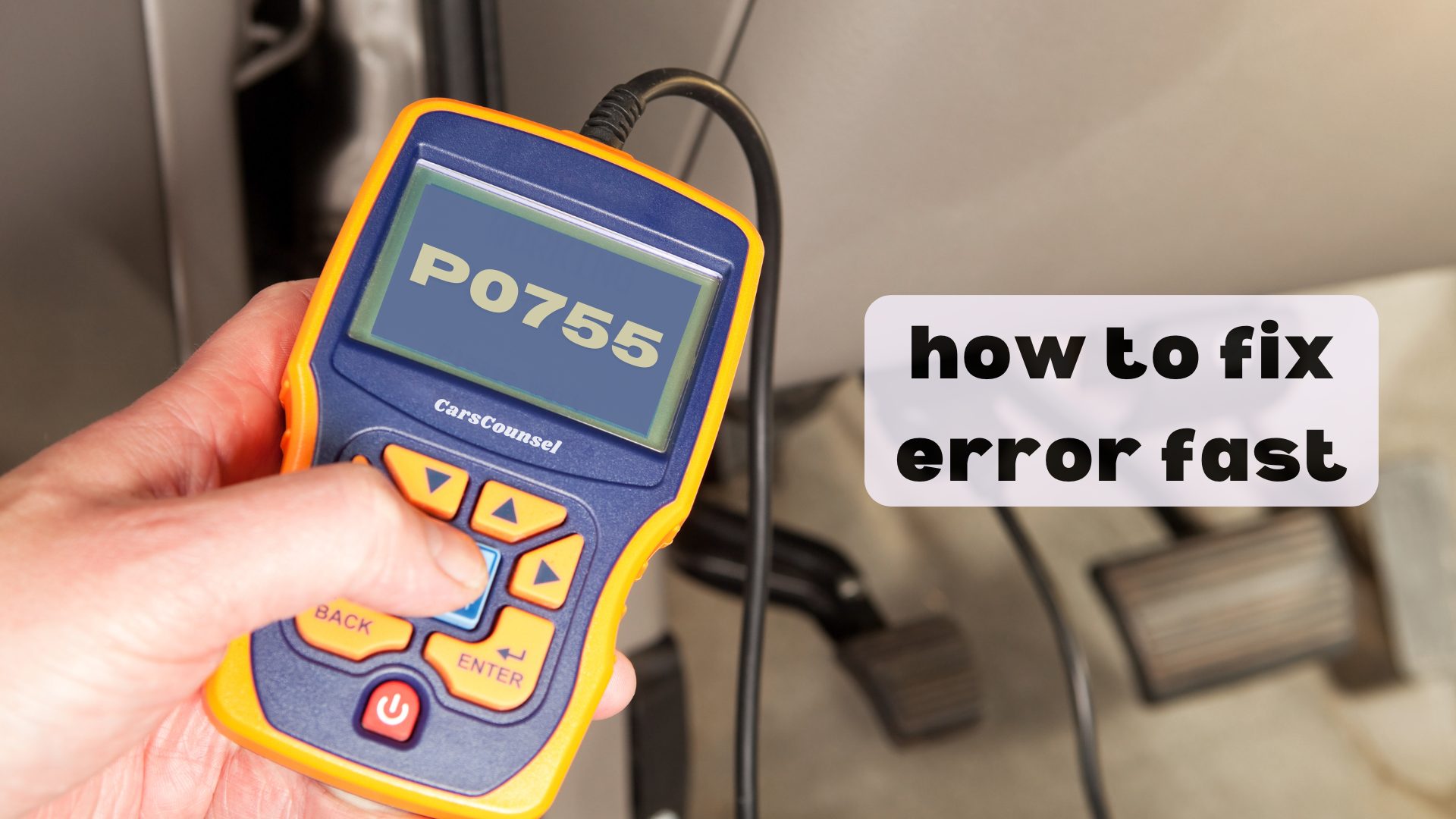Encountering a P0755 code can be frustrating, but you can fix it quickly with the right steps.
Start by connecting an OBD-II scanner to confirm the OBD2 error.
Next, check the wiring and connectors for any damage or corrosion that might be affecting shift solenoid B.
Don’t forget to check your transmission fluid levels and condition.
If those steps don’t fix the issue, you might need to test the solenoid’s resistance with a multimeter.
If the solenoid turns out to be faulty, let’s look into what you should do next.

Quick Navigation
Key Takeaways
- Check and add transmission fluid if it’s low.
- Look for any damaged or rusty wires and connectors, and fix them.
- Use a multimeter to test the shift solenoid’s resistance and replace it if it’s bad.
- Use an OBD-II scanner to find and clear any error codes after making repairs.
What Is the P0755 Code?
The P0755 code means there’s a problem with shift solenoid B, which helps control the flow of transmission fluid and ensure smooth gear changes in an automatic transmission.
When this code shows up, it signals a specific issue with the shift solenoid that could lead to bigger transmission problems. The shift solenoid manages the fluid pressure needed for smooth gear shifts.
If it stops working properly, your vehicle might experience rough or delayed shifting. This issue can be caused by electrical problems, low transmission fluid, or wear and tear on the solenoid.
Fixing the P0755 code quickly is crucial to keep your car running smoothly and to avoid more serious transmission issues later on.
Common Symptoms
If you’re dealing with the P0755 code, you might notice some clear signs like your car shifting strangely, the transmission slipping when you speed up, or odd noises. The check engine light might also come on.
Many people think these problems are always due to low transmission fluid, but that’s not always true. To figure out what’s wrong, listen for weird sounds like grinding or whining, which can mean bigger problems.
Pay attention to how your car shifts—if it feels rough or takes longer than usual, that’s a big clue something’s wrong. Make sure to write down anything unusual you notice; this can help mechanics find and fix the issue faster.
Also, check for other related codes to fully understand the problem.
Potential Causes
Why might your vehicle be showing the P0755 code?
The main reason is often a bad shift solenoid, which can cause delays and odd shifting. Over time, solenoids can wear out and mess up the flow of transmission fluid. You can test the solenoid with a multimeter to see if it’s the problem.
Another possible reason is low transmission fluid, which can mess up both the solenoid and the transmission. Issues with the transmission valve body can also affect how the solenoid works. Make sure to check these parts carefully.
Electrical Issues
Electrical problems like damaged wires, rusty connectors, or loose connections can mess up how shift solenoid B works, causing the P0755 error code.
Here’s how to fix these issues:
- Check the wiring: Look for any damage, like frayed wires or worn-out spots.
- Inspect the connectors: Make sure the connectors are clean and not corroded, as this can block the electrical flow.
- Tighten loose connections: Secure any loose connections to avoid inconsistent electrical contact.
- Test the wires: Use a multimeter to check if the wires and connectors are working properly.
Transmission Fluid Levels
To make sure your transmission works well, you need to keep an eye on the fluid levels and add more when necessary.
First, check your vehicle’s manual for specific tips on how to take care of the transmission.
Make sure the engine is warm and the car is on a flat surface. Take out the dipstick, wipe it clean, put it back in fully, and then take it out again to see the fluid level.
If it’s low, add the recommended fluid a little at a time, and don’t overfill it.
It’s also important to change the fluid regularly—most car makers say to do this every 30,000 to 60,000 miles. Clean fluid helps everything work smoothly and prevents issues.
Keeping the fluid levels right is a simple but crucial part of making sure your transmission stays in good shape.
Diagnostic Steps
Start diagnosing the P0755 error by connecting an OBD-II scanner to your car’s diagnostic port to read and record any error codes. These tools help identify related problems.
Follow these steps to troubleshoot:
- Inspect Wiring and Connectors: Look for visible damage, corrosion, or loose connections around the shift solenoid.
- Check Transmission Fluid Levels: Make sure the fluid is at the correct level and in good condition; low or dirty fluid can cause problems.
- Test Shift Solenoid: Use a multimeter to check the solenoid’s resistance and continuity to ensure it’s working properly.
- Conduct a Road Test: Drive the car to replicate the symptoms and observe how it shifts to confirm the issue.
These steps will help you find the problem and lead you to a solution.
Affected Vehicles
After you finish the diagnostic steps, it’s good to know which vehicles often have the P0755 code.
This issue commonly affects certain years of Honda Civic, Accord, and CR-V, especially those from the early 2000s.
Toyota Camry models from the late 1990s and early 2000s, as well as some Ford Expedition models from the same period, also tend to have this problem.
These cars usually have automatic transmissions that use shift solenoids to control fluid flow and gear changes.
Knowing if your car is one of these models can help you understand the chances of facing a P0755 code and get ready for possible repairs.
Replacing the Solenoid
Replacing the shift solenoid usually means getting into the transmission pan, so you’ll need to drain the transmission fluid first and then take off the pan to see and reach the solenoid. Here’s a straightforward way to do it:
- Drain the Fluid: Carefully drain the transmission fluid so you don’t make a mess.
- Remove the Pan: Unscrew and take off the transmission pan to get full access.
- Find the Solenoid: Locate the bad solenoid; check your manual to know which one it is.
- Put in the New Solenoid: Disconnect the old solenoid and attach the new one, following any tips for proper installation.
Make sure all connections are tight and use new gaskets to avoid leaks.
Double-check that the solenoid type matches what’s needed, and always tighten bolts to the manufacturer’s recommended settings.
Repairing Wiring
Fixing wiring problems involves looking at all visible wires and connectors for damage, rust, or looseness.
Start by checking wiring diagrams made for your specific vehicle to understand the electrical paths and find the right connectors.
Look closely at each wire for any breaks or wear and make sure all connections are tight.
Use a multimeter to check for continuous electrical flow and any drops in voltage.
If you find any damaged wires or connectors, replace them with the correct ones shown in the diagrams.
Make sure to crimp or solder new connections properly to prevent rust and ensure a strong link.
Double-check everything before putting things back together to prevent the same issues from happening again.
Cost of Repairs
When figuring out how much it will cost to fix a P0755 code, the expenses can vary a lot depending on what’s wrong and what kind of car you have.
Here’s a general idea of what you might expect to pay:
- Replacing the Shift Solenoid: The solenoid itself usually costs between $50 and $150. Adding labor, it could total $100 to $300 more.
- Fixing the Wiring: This can cost anywhere from $50 to $200, depending on how complicated the problem is.
- Replacing the Transmission Valve Body: This is a pricier fix, costing between $400 and $1,000.
- Topping Up the Transmission Fluid: This is a simpler and cheaper fix, usually costing around $20 to $50.
Each repair has specific steps, so knowing these costs can help you plan your budget.
Always check with a professional to get exact prices for your car.
More OBD-II Codes
Frequently Asked Questions
Can Driving With a P0755 Code Damage My Transmission Further?
Driving with a P0755 code can put extra strain on your transmission because the solenoid isn’t working properly. This can cause your car to shift gears unpredictably and may result in more damage. It’s smart to fix the problem right away to avoid expensive repairs.
What Tools Do I Need to Replace a Shift Solenoid Myself?
You’ll need a diagnostic tool, a set of sockets, and a multimeter to replace a shift solenoid yourself. Just follow the steps, and you’ll have your transmission shifting smoothly again in no time!
How Long Does It Take to Fix a P0755 Code Issue?
Fixing a P0755 code issue usually takes between 2 to 4 hours. This time includes steps like checking the wiring, testing the solenoid, and fixing or replacing parts. The exact time can vary based on your skill level.
Are Aftermarket Solenoids Reliable for Fixing P0755 Code-Related Problems?
Aftermarket solenoids can be reliable for fixing P0755 code-related problems, but their lifespan can differ. Always look up brands and check reviews to make sure you’re getting a good quality part that works well.
Can a P0755 Code Affect Fuel Efficiency Significantly?
If your car shows a P0755 code, it can seriously hurt your fuel efficiency. Run some diagnostic tests right away to find and fix the problem. Ignoring it could make your fuel economy worse and lead to expensive repairs later on.
Conclusion
To sum up, fixing a P0755 code needs a step-by-step approach.
If your car’s transmission fluid is low, adding more might solve the problem.
But if the wiring is damaged, you’ll have to fix or replace it.
Quickly finding and fixing the issue, like replacing a bad solenoid, will help your car run smoothly and avoid more transmission problems.
Always use an OBD-II scanner to check the error before you start any repairs.

